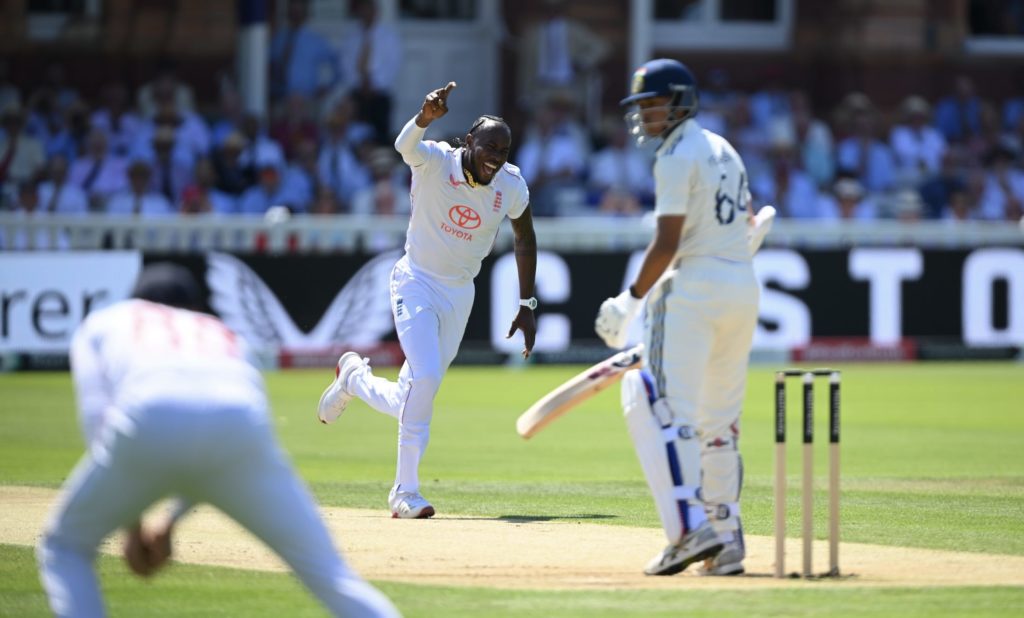After years of injury setbacks and long rehab sessions, Jofra Archer finally made his long-awaited Test comeback—and it couldn’t have started on a better note.
The third delivery of his spell sent a jolt of excitement through Lord’s as it seamed away just enough to catch the edge of Yashasvi Jaiswal’s bat.
Harry Brook made no mistake at second slip, and Archer, roaring in both relief and joy, embraced Shoaib Bashir before taking in the crowd’s thunderous applause.
For England fans, it was more than a wicket—it was a moment of hope.
Clocking in at 90mph, Archer’s delivery was a stark reminder of what England had missed.
After nearly 1,600 days away from Test wicket columns, the speedster had finally returned to put India on the back foot early.
England’s Bowling Attack Teases a Bright Future
With Archer back in the mix and Gus Atkinson aiming for a comeback in the next match, England’s pace attack is slowly regaining its bite.
Mark Wood might still feature at The Oval, and with options like these, England fans are dreaming big.
But managing workloads and expectations will be crucial.
For now, Archer’s presence alone signals a shift towards a more hostile, fast-paced attack.
His dismissal of Jaiswal—his teammate at Rajasthan Royals and one of India’s batting stars—was a key breakthrough.
With India chasing England’s first-innings score of 387 on a pitch that had started to quicken slightly, Archer’s early strike gave England a clear edge.
Root’s Magic in the Field Adds to India’s Woes
Joe Root continues to prove that he’s not just a batting icon but also a force in the slips.
His stunning catch to remove Karun Nair for 40 was arguably his finest yet and took him past Rahul Dravid to become Test cricket’s top catcher.
Root now has 211 catches—an incredible milestone in an already glittering career.
Shortly after, Chris Woakes, who had struggled with his line and length, was rewarded when Jamie Smith pulled off a sensational catch standing up to the stumps to dismiss the dangerous Shubman Gill for just 16.
With 585 runs in the series so far, Gill had eyes on Don Bradman’s record—until that sharp dismissal changed the tide.
India Fight Back but Trail by Over 200 Runs
Despite the setbacks, India ended the day at 145 for three, still trailing by 242.
KL Rahul, ever the steady hand, remained unbeaten on 53, supported by Rishabh Pant, who shook off a finger injury to bat aggressively.
India’s depth in batting means the game is still wide open, but England’s early breakthroughs ensured they finished the day in control.
Root Reaches Another Landmark with a Century
Earlier in the day, Root wasted no time reaching his hundred.
Having gone to bed on 99, he smashed Bumrah’s first ball of the day through gully for four, notching up his 37th Test ton—his 11th against India and eighth at Lord’s.
Only Kumar Sangakkara stands ahead of him on the all-time list now.
But India hit back hard through Bumrah.
The pace ace knocked over Stokes with a beautiful delivery that nipped back and bowled him for 44.
Soon after, Root himself was undone—an inside edge ricocheting onto his stumps for 104.
And in the very next ball, Bumrah had Woakes feather one to the keeper, though DRS had to confirm it.
Smith and Carse Rescue England from a Collapse
With England at 271 for seven, the innings was teetering on collapse.
But Jamie Smith, given a reprieve on 5 after Rahul dropped him, took full advantage.
Along with Brydon Carse, who posted his maiden Test fifty, the pair added 84 crucial runs.
Their efforts gave England a much stronger platform than expected after the top-order wobble.
Bumrah eventually claimed Archer to complete his five-wicket haul—his fourth bowled dismissal of the innings.
Meanwhile, Siraj and Akash Deep, who had run riot in the previous match, struggled to make an impact, combining for just two wickets at a steep cost of 177 runs.
Slow Over-Rates Spark Frustration Among Fans
Despite the gripping cricket, one issue left fans grumbling: the glacial pace of play.
Only 22 overs were bowled before lunch, and just 44 by tea. By stumps, 15 overs had gone missing.
With tickets as high as £175, spectators are beginning to question the value for money when nearly a sixth of the day’s play isn’t delivered.
Part of the blame lies in repeated complaints about the condition of the ball and the general lack of urgency from players and umpires alike.
The slow tempo may have added drama, but it’s a recurring issue that threatens to tarnish the Test experience.
Archer’s Speed Shines Brightest on the Day
If there was one silver lining, it was Jofra Archer’s pace.
His first spell averaged nearly 90mph—one of the fastest new-ball bursts for England since 2006.
Even in his later spells, his speed remained high, and his tight lines kept India in check after their dominant displays in the previous Tests.
Archer’s 10-over spell cost just 22 runs.
It was a performance filled with purpose, precision, and promise—exactly what England needed to regain momentum.
Woakes Shows Signs of Fading, But Leaves a Mark
On the other hand, Chris Woakes had a difficult day.
His opening over went for 13, and his usually reliable rhythm deserted him.
Though he managed to dismiss Gill, it felt more like a gift than a reward for consistency.
At Lord’s—one of his favourite venues—his struggles were all the more noticeable.
Whispers are growing that we may be watching the final chapter of Woakes’ Test career.
He’s been a workhorse, a skilled operator, and a true team man.
And if he can help secure one more win before bowing out, it would be a fitting farewell.
Final Thoughts: The Series Hangs in the Balance
As it stands, India have plenty of batting to do, and England hold a decent lead.
The Test has all the makings of a thriller, and Archer’s return has added new life to the series.
With more pace options waiting in the wings, the future looks exciting for England—if they can keep everyone fit and firing.
For now, fans can savour a fascinating day’s play, made even better by the story of a fast bowler who never gave up and is finally back doing what he loves.



